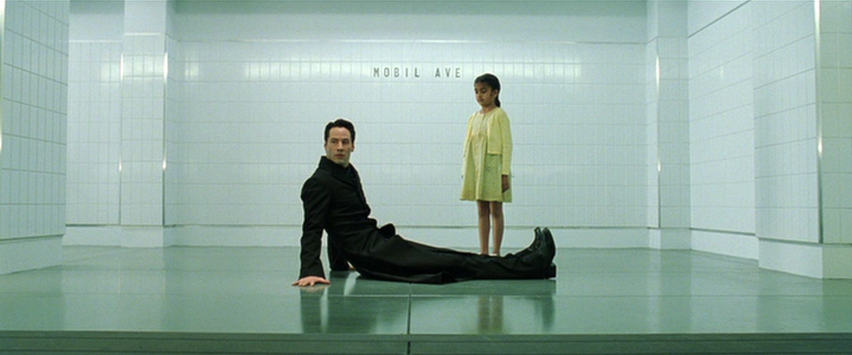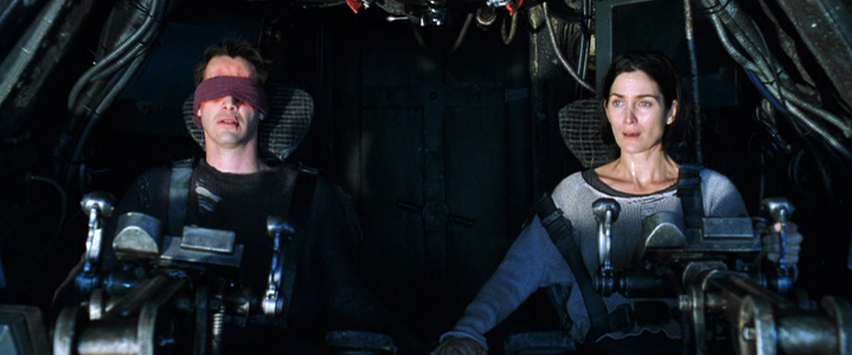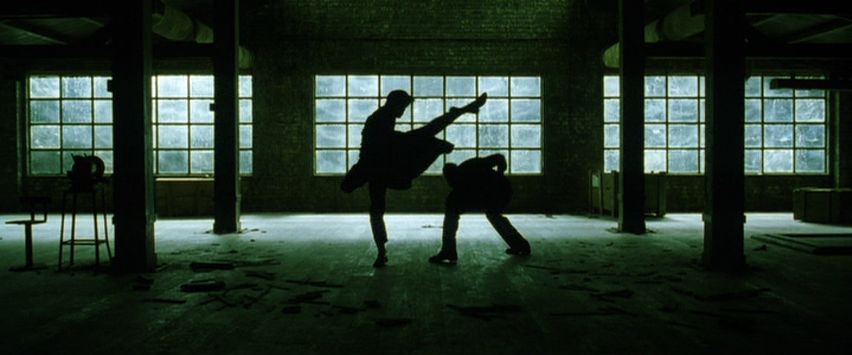

“Do you believe you’re fighting for something? For more than your survival?”
As The Matrix Trilogy comes to a close, it is fair to question if the Wachowskis really had a plan for the series, or if they were making it up as they went along. Part of me could sit and read fan theories for days and marvel at the complexity of the films, but then there are a number of obvious holes and incohesive plotlines that sour my perception. To put it succinctly: the final film—The Matrix Revolutions—is a letdown, and what appears onscreen is a betrayal of the filmmaking philosophy that propelled the original to cinematic greatness. Gone is the carefully considered philosophical nuance; gone is the thematic depth; gone is any real attempt at character development. Matrix Revolutions tries to bring the trilogy to a satisfactory conclusion, but its narrative seams begin to unravel and the filmmakers continuously rely on spectacle and symbolism to carry it to its disappointing end.
The first portion of the film concerns Neo becoming suspended in a realm in between the machine world and the Matrix, a train station called Mobil Ave (“mobil” is an anagram of “limbo”). Somehow, Neo has been granted the ability to use his powers outside of the Matrix, and to “jack in” without a wired connection. The transitory train station—used for smuggling programs between worlds—is overseen by the Trainman (Bruce Spence), who keeps Neo stuck there until The Merovingian (Lambert Wilson) decides he can leave.

Seraph (Collin Chou) accompanies Morpheus (Laurence Fishburne) and Trinity (Carrie-Anne Moss) to confront The Merovingian at Club Hel, where he dines with his wife Persephone (Monica Bellucci). They are able to free Neo, but he immediately wishes to consult with The Oracle (Mary Alice). We learn from The Oracle that Agent Smith (Hugo Weaving) is a virus that will overtake the Matrix and the real world if Neo (Keanu Reeves) cannot stop him. Having made the choice to risk the fate of humanity rather than allow Zion to be destroyed and the Matrix reset, Neo comes to a mystical understanding that he must go to the machine city.
As the tentacled sentinels burrow their way toward Zion, the team splits up—Niobe (Jada Pinkett Smith) offers her ship so that Neo and Trinity can head into enemy territory, while she, Morpheus, Link (Harold Perrineau) and the others head back to Zion with their EMP that may be able to save the last bastion of humanity. Bane (Ian Bliss), who had become infected by Agent Smith in The Matrix Reloaded, sneaks onto the ship with Neo and Trinity, and manages to blind Neo before Neo kills him. Though Bliss has only a small role, he really nails the mannerisms that Hugo Weaving had employed as Smith.
The defense of Zion is thrilling in the sense that it is non-stop action, but little of note occurs considering how much time is dedicated to it. Captain Mifune (Nathaniel Lees) leads a group of soldiers who control mechanized war suits with large machine guns.1 The Kid (Clayton Watson) is an ammo runner who must take over the fallen Mifune’s mech suit to cut the counterweight that allows the gate to open for Niobe and Morpheus upon their return. The duo of Zee (Nona Gaye) and Charra (Rachel Blackman) tote a bazooka around the battlefield, and successfully take down a large screw-like machine that burrows its way through Zion. When Niobe gives the order, Link sets off the EMP which shuts down all machines in the vicinity. After a momentary celebration, more sentinels attack, and since the EMP took down some friendly machinery as well, the defenders of Zion prepare for their last stand, and hope that Neo can save the day. This whole section of the film is mostly forgettable, and Jada Pinkett Smith’s performance is the only one deserving of a second glance.

In a delightful reprieve from the non-stop flashing lights, explosions, and gunfire, Neo and Trinity fly above the clouds, and see the real sun for the first time (or, at least Trinity does). Neo, doing his best impression of Paul Maud’dib in Dune Messiah, confronts the baby-faced Deus Ex Machina, the central interface of the machine city. Countless sentinels assemble themselves into a formation that resembles a human face and speak in a mechanical voice. Neo offers to stop the Agent Smith virus in exchange for peace between humans and machines.2 The machines agree and provide Neo with a jack into the Matrix. Having assimilated The Oracle, Smith has foreseen his victory in the climactic battle. After a long, slow-motion, epilepsy-inducing fight scene, Smith sticks his hand into Neo’s chest and begins to turn Neo into a clone of himself. But then Neo as Christ-figure emerges, sacrificing himself as he lays prone, arms spread in the machine world, a cross-shaped burst of light emanating from his chest.3 Because he is now part of the Smith program, his self-destruction also destroys all of the Smith clones as they burst apart into light. The machines stand down and Zion is saved.
The final battle between Neo and Agent Smith is incredibly indulgent, and serves as a prototype for the climactic battles of the comic book movie genre. It has flashes of brilliance but there are just too many attempts at high points for it to have much impact.
On paper, the ideas sound fine. But similar to The Matrix Reloaded, Revolutions seems intent to make the action—rather than the story, themes, and ideas—the focal point, and it is worse off for it. CGI, used so sparingly and tastefully in The Matrix takes an unfortunately large role here—not only in the exaggerated hand-to-hand combat scenes, but the machines, the ships, the mech suits. It’s all over the place.

The action elbows out any room for the development of secondary characters, with Zee and Link’s relationship being the one measly exception. The Kid is still mostly extraneous, and Captain Mifune has no backstory at all but is supposed to be viewed as an authority figure. Much is hinted at, but not enough appears on screen—perhaps another side effect of the Wachowskis’ attempt at transmedia storytelling. In The Matrix and Reloaded, we had “lesser” scenes—moments of calmness, dialogue, exposition, flavor—but here we have only action scenes. It seems like the Wachowskis didn’t realize how much the story would balloon, and kind of painted themselves into some corners on certain things, and then just tried to mask it all with fight scenes to get us stumbling to the finish line.
Neo, the central character of the trilogy, gets lost for long stretches of Revolutions and while thematically his role in the climax works fine (i.e. I don’t mind the allusions to Christ), it is muddled and ham-handed. The first film was succinct and intriguing, leaving audiences to formulate theories and generate additional ideas, but the concluding film is itself confused and offers a disappointingly mushy foundation from which to discuss it.

The Matrix (and to some extent The Matrix Reloaded as well) was noteworthy because it coupled its eye-popping action with an intriguing mythology, philosophical depth, and a provocative premise. The Matrix Revolutions in story form seems to move in the same direction as its predecessors, but its execution falls flat, and it almost succumbs to the fate of the countless action films that The Matrix was (and still is) a refreshing relief from. It is unimaginative, dull-witted, and bland. I don’t entirely blame the creators. Although we can’t know everything that goes on in corporate offices, it is likely that after the success of The Matrix, Warner Bros. threw a bunch of money at the franchise and wanted to ensure a return on their investment, and too many cooks ended up in the kitchen, leading to a confused mess rather than the careful, subtly crafted brainchild of the Wachowskis. Maybe that’s why we have approximately half the runtime dedicated to fight scenes, a chesty Monica Bellucci (who is a solid actress in her own right—see Irréversible or Specter—but only has one line in Revolutions), and ads for Powerade. But the Wachowskis didn’t shy away from cliche in The Matrix, they were able to transcend it.
In the end though, you have to see it, right? If you enjoyed the original, you will want to know what happens next, and Reloaded is good enough to warrant an attempt at Revolutions. Even though Revolutions is a bungled mess, clumsy in many of the areas the original was superb, it still provides a conclusion, even if it feels half-baked and confused. As the film concludes, The Oracle predicts that we will see Neo again someday. If we do, perhaps we’ll be provided with a more fitting conclusion to the series. Until then, this is what we have.
1. Let’s not even get into the stupidity of manufacturing armored suits—for warfare—that don’t have any sort of protection for the operator.
2. This sounds nice and poetic, but when did we go from desiring freedom from the machines to desiring only peace?
3. The ship they flew in on was called The Logos for crying out loud.